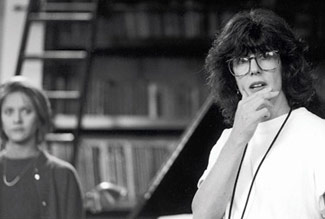Nora Ephron
46. Sleepless in Seattle, directed by
Nora Ephron
It’s a Kind of Magic
By Rose Marel
Does magic really exist? And no, not the ‘Abracadabra’, pull-a-rabbit-out-of-my-hat, cloak-billowing, top-hat-wearing kind of magic; but a different kind of magic. A magic between two people. Sam (Tom Hanks) thinks it exists because he’s experienced it before – when his wife was alive. Still grieving her loss to cancer, he remembers the magic that disappeared when she did– leaving him and his eight-year-old son alone with a puff of smoke, dazed in the aftershock.
Annie (Meg Ryan) isn’t too sure. Living in Baltimore, she’s content in her relationship with Walter, blankly ignorant to the mere possibility that such a ‘magical’ connection exists. Oh, isn’t ignorance indeed blissful! Their relationship is one of clockwork – practical, unromantic and functional. They work just fine thank you! Then Annie hears Sam on the radio, all the way in Seattle, soliloquising about his past love; both a person and an experience – one so perfect it felt like “coming home.” This instantaneousness of two souls connecting is a concept so foreign to Annie, and so romantic, that she finds herself unexpectedly moved by his story.
The reason Sam’s on the radio is thanks to his son Jonah, who secretly called the station, concerned about his father’s inability to move on. Selfishly, too, he just really wants a new mother. The unfolding of Sam’s discovery that he’s been set-up live, on-air, is a hilarious one. Skulking in another room, hiding like a guilty dog, Jonah is hunted down by Sam, both on separate phones as they face-off. Meanwhile radio listeners become engrossed in the show’s spontaneously juicy material. What begins as a coercive interrogation by Dr. Marcia Fieldstone soon progresses into the vulnerable outpouring of long-repressed emotional baggage.
In the days after, Annie can’t shake the program from her head. More than anything, it’s his description of some kind of subatomic love that awakens her, by striking a dissonant note within her own life. Does this magic really exist? If she has it with Walter, wouldn’t she know it? Can two positives make a negative? Annie is torn between her emotions and her practical head: one screaming for romance, and one grounding her in logic. What she has with Walter is great (but does great equate to magic?). As she struggles and Sam carries on, oblivious to the internal messes he’s caused all across the country, it’s the audience who can match-make. Early clues reveal that Annie and Sam are somehow destined for the other, like reacting in sync to Dr. Marcia’s remarks, and sharing similar interests. As the film develops, these pieces of evidence start stacking up, and parallels between Sam’s late wife and Annie become more defined.

Part breath of fresh air, part artificial breeze, Sleepless In Seattle feels comparatively original beside its chick-flick contemporaries. Let’s be honest, the genre’s formula usually revolves around one of the following: the perfect couple who work through 90 minutes of trials to eventually live happily ever after; the best friends who forgo their respective partners to unsheathe the love for each other (that was right there from the start); the couple who can’t be together but get together by the end; unrequited love that leads to requited love; a mutual hatred for each other that burns so strongly that it then scorches away its own disgust until love rises from the ashes. Technically speaking, Sleepless In Seattle could fall within the third category, but it bypasses convention by leaving the characters as strangers (and in different states, no less).
Here, the individual is focused on, and it’s only from our dual vantage point that we can recognise how perfect they’d be together. It’s interesting to see the characters as distinct individuals, leading separate lives, with corresponding visuals drawing them together in the audience’s mind. This leads into the crucial role that location plays, as an impediment and an anticipation-building device. In spite of their geographical divide, through collocating their similarities – that crackle of magic-in-waiting – their need to unite is visually validated. In one bittersweet recognition of potential, Kent juxtaposes the pair on corresponding jetties, alone and melancholy in different US States. We see that the world can be both so vast and so small and that, ultimately, humanity is what will always overcome divides.
Keeping them independent further empowers each character – they arrive at their own conclusions and work through their own issues, rather than the traditional collaborative transformation. Annie, in particular, is the agent of change. As a bold (and confused) female character, it’s her audacious risks (and of course, a bit of movie-style luck) that poke a hole in the wall between the protagonists. As usual, Meg Ryan and Tom Hanks are both delightful, bringing the same level of fun, energy and believability that they do to most roles.

Aware of its own heightened romance, which maybe leads to its eventual downslide in plot plausibility, Sleepless In Seattle alludes to the role of film in warping our expectations of love and life. It’s a cheeky, self-referential ribbing, an ironic acknowledgement of certain improbabilities, but it reaches further, as An Affair To Remember becomes actual inspiration for the characters. This particular film is a running reference, as one of Annie’s favourite films, which speaks of female sentimentality and the human desire for love.
Mostly though, it’s all simply light-hearted fun, bundled up as a fluffy cardigan to comfort you on a winter’s day. Sometimes, as in the case in Sleepless In Seattle, implausible storylines can fall to the wayside if laughter and entertainment are strong enough to override it. Of its genre, it does very well, as evidenced by its box office success, and the fact that even today, it’s still regarded as a romcom classic.